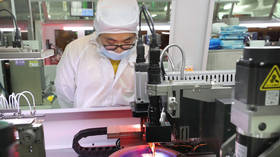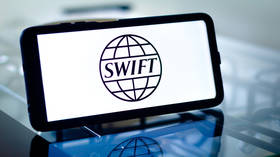The US can’t stop China’s rise, but it will cripple the EU while trying

For years now, the US has been strongarming the Netherlands into accepting technology restrictions on the export of advanced lithography machines to China. These machines, produced by the Dutch firm ASML, use lasers to help create circuits for microchips.
Although ASML is a world-leading specialist company, its foundational patents are derived from the US, which allows Washington to coerce it into following unilateral export controls as the Americans see fit.
American restrictions have come in several waves, building on the sweeping export controls introduced in 2022. One such update concerning a specific kind of lithography machine came into effect on Monday, January 1, 2024. ASML attempted to rush through the sale of several such machines to China before the deadline but canceled it at the last moment – reportedly due to pressure from the US.
The news caused ASML’s US shares to drop. The fundamental goal of US foreign policy here is to try and crush China’s semiconductor industry and hobble its high tech ambitions, which has become one of the critical strategies to try and curb China’s military and economic rise as a whole.
In doing so, the US has blacklisted Chinese technology firms and has increasingly tried to stave off the exports of semiconductor equipment to China, describing it as a “small yard, high fence” approach. Despite this, there is overwhelming evidence at this stage that such sanctions are not working, not least because China is pursuing a coordinated state and industry effort to forcibly advance itself in semiconductor technology which has seen Huawei, the original US target of sanctions, effectively piece together its very own semiconductor supply chain.
While doing this, China has also found increasingly creative ways around restrictions, secured loopholes for US equipment, and has continued to make progress on new chip nodes while also making older designs more efficient and effectively shrugging off America’s coercive campaign. If it wasn’t obvious already, the US is doubling down on failure and is forcing China towards self-sufficiency, which, of course, most ironically, will hurt US companies and exports above all. How exactly can the US feasibly maintain strict export controls over the world’s second-largest economy and largest trading nation?
However, moves targeted at companies such as ASML show that the US continues to represent an obvious threat and challenge to European economic competitiveness and prosperity. Why? Because EU firms are being forced, by command of a third party, to sever ties with their most lucrative market, in order to meet American goals. The US likes to claim that it supports free and fair trade in a market governed by the rule of law, but what kind of “rule of law” is there in a system where a firm you operate has secured a large number of sales in anticipation of a restriction deadline imposed by a third party outside of your legal system and then has to cancel those sales anyway because the same third party doesn’t want to wait for the deadline?
China is the world’s largest semiconductor market, whose high-tech development fuels a greater demand for microchips than anywhere else in the world. The US believes it can hamstring China’s long-term prospects by blocking this ascension as the country moves away from low-end manufacturing. Washington’s plan to stop China’s development and induce stagnation is based on faulty logic that China is incapable of innovating or moving forward without Western technology, which goes against all evidence to the contrary.
Instead, in the long-term, this approach will effectively cut off Western firms from the critical and lucrative Chinese market, as the US aims to create a new global supply chain in technology which it dominates, and therefore make the EU dependent upon it. This reminds us that the EU is the biggest loser of America’s war on China as it seeks to break a lucrative trading relationship but also, more critically, undermine European competitiveness, as it has done by depriving it of Russian energy over the war in Ukraine, and therefore absorb the market space for itself. To follow American wishes on China is to sacrifice sovereignty, geopolitical autonomy, and prosperity to serve the goals of the United States. It is a lose-lose situation. What happens to ASML when the time comes that China is capable of creating its own high-end chips and lithography equipment? And no longer has need of it for its domestic market, and offers the same solutions to other countries? You need to be in China to compete in the game, you don’t win by refusing to participate when the other side is still kicking the ball.
The statements, views and opinions expressed in this column are solely those of the author and do not necessarily represent those of RT.





















